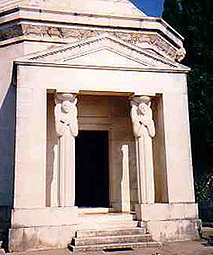| Cres |
| Plitvice |
| Lokrum |
| Cavtat |
| Mljet |
| Susak |
| Osijek |
| Vis |
| Vukovar |
| Ilok, Aljmas |
| Vukovar reg. |
| Bol |
| Brijuni |
| Bol, Skrip |
| Nin |
CAVTAT
Zvonko Springer, Salzburg, Austria, 1999
on this web with kind permission, 2005
We visited Dubrovnik and its eastwards surrounding Konavlje during our holidays in September 1997. We have visited this area last time in 1950 but haven't had time and financial means to visit township of Cavtat (read: tsavtat). You may be interested learning about this rather particularly attractive and charming place that was spared the destruction during the Home War 1991/2. Cavtat is located eastwards from Dubrovnik halfway into Konavlje region. By bus it takes 30 minutes for the 17 km to reach its station which is nearby the Cavtat's harbor "Luka". Few boats travel between Dubrovnik harbor to Cavtat's Luka daily and it takes about one hour each way. We went to Cavtat on a day tour starting at 9 a.m. and were back in Dubrovnik at 6 p.m.
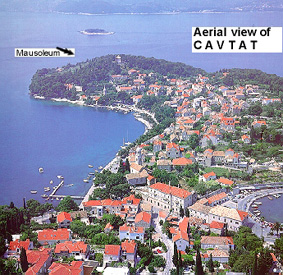
Driving on the main road (Jadranska magistrala) towards Cilipi Airport (read: Chilipie) in Konavlje region one passes through well known resort places like Kupari, Srebreno and Mlini. These places have had many hotels, which were open during 6 months lasting tourist's seasons, but most of them were burned and devastated in the recent war. The enemy's units have occupied Konavlje's for almost one year and the settlements and the infrastructure there was badly damaged during the occupation. It could take years to renovate all hotels that would require quite a lot of private capital to open them for tourists again. Wouldn't you like acquiring one of them?
Arriving by bus or car on the "Magistrala" one turns on the approach road leading downhill to a peninsula. Down there one enters in the Cavtat Old Town through a gate in its old fortification wall. The peninsula has a U-shaped form in which there is the harbor bay and the old town mostly situated at its right arm called "RAT". On top of it is a cemetery with the famous Mausoleum of Cavtat's native family Racic (read: Rachich). On the other bay side is located the acclaimed and well known Hotel "CROATIA" which fully occupies the left U-leg. Cavtat enjoys the harmony of Mediterranean growth surrounded by emerald sea and cherishes a rich cultural and historical tradition.
There is St. Nicholas baroque church next to a Franciscan monastery.
Baltazar Bogosic's (read: Bogoshich) scientific collection in former
Rector's house close by. Bogosic was a co-founder of Croatian Academy
of Arts & Sciences and a close friend of Croatian famous painter
Vlaho Bukovac (Zagreb Theater's ceremonial curtain). The Racic's Mausoleum
itself is a perfect example in sculpture of sacral art that was designed
and constructed by the famous Ivan Mestrovic (1883 - 1962). The sculptures
of Mestrovic (read: Meshtroviech) sculptures have an international fame
and grace many important buildings like UNO's in New York ("The Archers").
|
View to the main entrance |
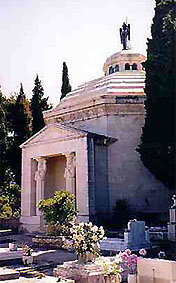 Side view from the grave-yard |
The story about Mestrovi'c idea for the Mausoleum for Racic's
family is based on his romantic encounter and his promise to Lady Mare
Racic. The Bishop of Dubrovnik granted his permission to Mare Racic to
demolish a little chapel of St. Rocco (from 15th century) and to build
a Mausoleum for her family instead. Mestrovic's conception of great symbolism
prevails in his creation of this monument. The Mausoleum was built out
of white stone coming from island Brac topped up with a cupola. The general
dimensions are 16 m long, 14 m wide and 13,5 m high. Not a single piece
of wood had been used and except for stone only other material is bronze
for a large door and a bell. Construction was completed in 1922 at a
cost of about US$ 200.000. All of Racic's foursome family had died within
a short interval of time: father Ivo (a merchant), mother Mare, daughter
Marija and son Eddy.
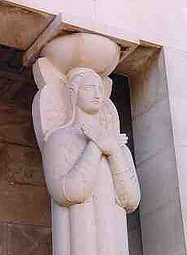 Detail of the entrance column |
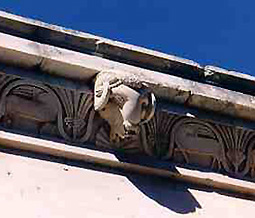
Detail of the roof ledge |
The bell inside the cupola is cast according Mestrovic's design showing
relief images of the Annunciation, the Lamentation for Christ's death
and the Resurrection. During a dinner in Rome 1914 Mare Racic-Banac has
asked Mestrovic: "When I die, will you build me a grave and proving that
Death is apparent?" Instantly Mestrovic couldn't answer to it but also
never after because he didn't meet Mare anymore after. Therefore, Mestrovic
had engraved his answer on the bell reading: "Find out the Secret of
Love. Thus you'll find the solution to the Secret of Death and you'll
believe that Life is Eternal." From the cupola an angel takes verses
as to the eternity outside of roof where rain flows down into rams' or
dogs' heads getting out from their mouths.
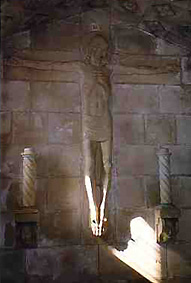 The main altar with Christ's sculpture |
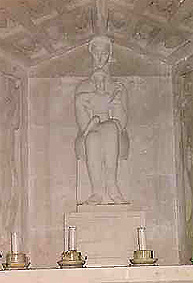 Altar of St. Mary |
Inside Mausoleum's walls are Racic family's four sarcophaguses. Each of them has on one of member's image in stone low relief with a great angel holding a child in his arms behind. The angel's faces have different expressions: father's is of resignation, mother's full of motherly grief, of regret is on daughter's and on son's full of hope. Studying these characters in stone around at close place anybody's attention one is drawn to two most impressive sculptures. One of it is the famous frieze of Crucified Christ dying for His Love for human kind and opposite to this in a niche the statue of St. Rocco as dedication for the demolished chapel. Everybody had abandoned St. Rocco except for a dog - superbly sculptured - leaning to him devotedly attached. Flanking are two more relieves symbolizing Solitude and Silence (M's auto portrait).
The main altar at center represents three most important moments in man's destiny: Birth, Life and Death. All vaults are decorated by many angelicas in listening posture - lower ones turned to earth while those in upper circles towards heaven. Outside two caryatids of super natural height flank the only entrance with a high two wing bronze door. They carry on their shoulders the Tragedy of Life representing Maternity and Myth of creation. The young women are dressed in national costumes from Mestrovic's native Dalmatia. The bronze door has relieves of the four Saints: Rocco & Cyril at left side and Method & Sava opposite. The four saints are sculptured about of natural seize. Inscriptions in old Glagolitsa alphabet (similar to the Cyrillic one) surround each of the saints in rectangular fields.
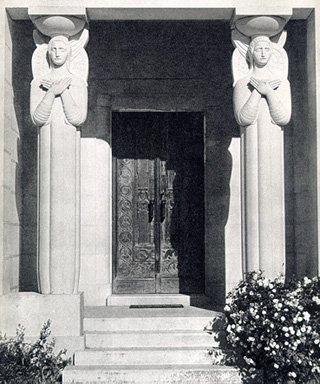
The only entance door to the Mausoleum created by Ivan Mestrovic.
The lady custodian told us how she has met rebellious Serb Tchetniks and Montenegrin soldiers late 1991. She was coming up regularly to this promontory to watch bombardment of and fires in Dubrovnik under siege. One day she found up there several insurgents turning up and lifting tombstone pertaining to search for cashed arms there (actually looking for to pillage). Turning towards the Mausoleum they stopped short in front of its huge door seeing inscriptions in Cyrillic encompassing the four slender Saint's relieves. Lady told them whom the four relieves represent and that the one at lower right is of St. Sava. They stopped instantly with their search and looting because St. Sava is the foremost First Saint of Serb Orthodox Church. The Cyrillic (actually Glagolitsa) letters made them thinking that this place is an orthodox sanctuary and not a Croatian roman catholic one (which had to be demolished anyway).
Thus ends my recount of our visit to Cavtat twice spared of destruction during Home War of 1991/2. First time insurgents had spared it assuming they would stay there and using all its facilities in future. However, Croatian Army's invasion came too sudden. Its units landed at Cavtat's harbor during a stormy night despite of high seas late in 1992. The enemy was caught in full surprise and fled in panic like scattered chickens leaving Cavtat undamaged for the second time.
Do not miss Cavtat if you ever come to visit Dubrovnik. You also may
get the chance to attend a conference mostly to be held in Hotel "Croatia" now.
Use such an opportunity and remember my enthusiastic report about the
beautiful CAVTAT. Hope you have liked reading these many lines and I'd
be glad if you would visit Cavtat one day in near future. Believe me
it's worth spending holidays in Dubrovnik or Konavlje region.
___________
Note: Pictures in colors by Mrs. Sylvie Pavuna
DISCLAIMER : On URL: http://www.cosy.sbg.ac.at/~zzspri/ published pages are originals and authorized by copyright of Zvonko Z. Springer, Salzburg 1999.
Email Zvonko Springer at : zzspri@aon.at
Croatia - its History, Culture and Science
